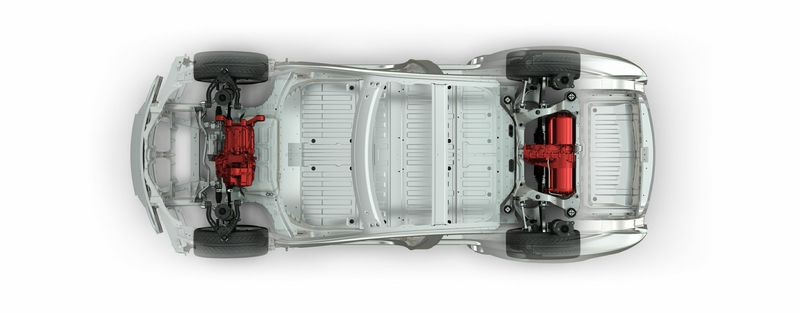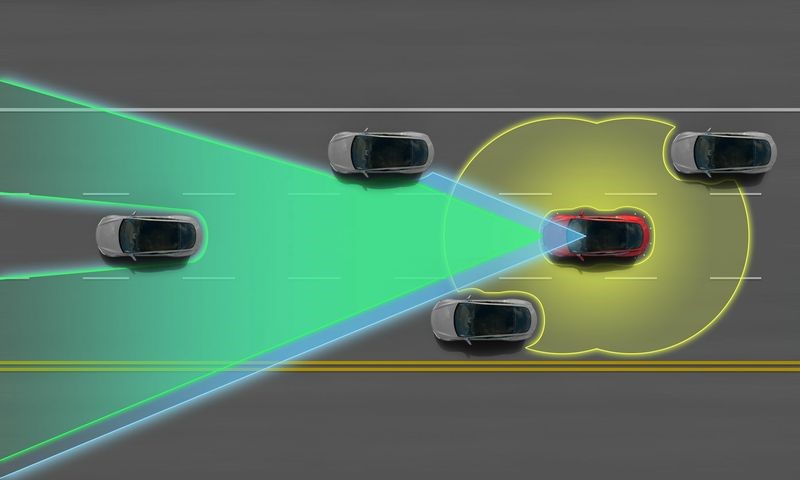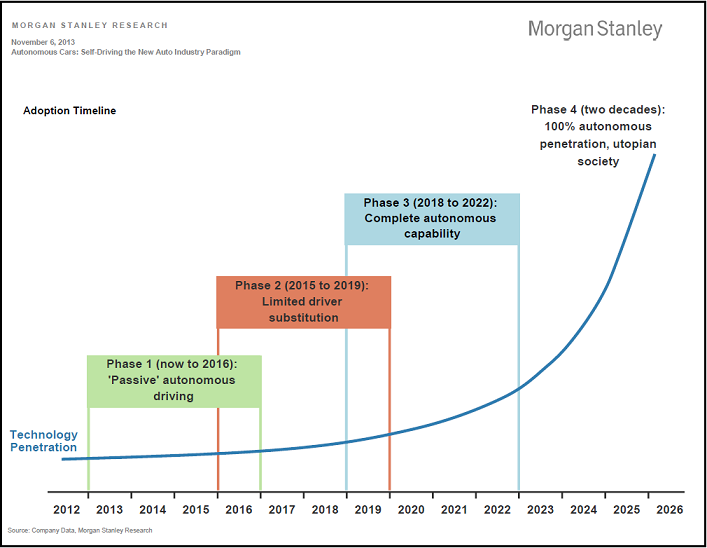Published at Breaking Energy, Oct. 24, 2014 (.pdf)
Elon Musk described the new Tesla Model D as a digital vehicle compared to conventional ICE autos which are analog mechanical machines. The Model D is an iterative upgrade of the Model S, but it presents two significant feature sets that demonstrate how the auto world is moving from the analog to the digital age and racing towards the era of the autonomous vehicle.
The first feature is represented by the ‘D’ which stands for dual motors enabling all-wheel drive. The second motor provides not only improved handling, as one would expect from all-wheel drive, but also improved acceleration, higher top end speed, and most surprisingly improved efficiency and range from the same battery pack. The high-performance version of the Model D will accelerate from 0-60 in 3.2 seconds, which is supercar territory.
Graphics by Tesla
Conventional ICE all-wheel drive always results in lower fuel efficiency due to the increased mechanical complexity. The Model D on the other hand, dynamically balances energy usage between the two motors to optimize efficiency and increase mileage range. Balancing the efficiency curves between the two motors allows them to overcome the additional weight of the second motor. The second motor also offers redundancy as either motor can drive the vehicle if one motor were to fail. Dual motors will be a common option going forward and updates to software and firmware will improve torque factoring and road handling under various circumstances and overall performance will continue to improve incrementally, even for cars that have already been sold.
The second upgrade are autopilot features that represent a major step forward on the path to driverless vehicles. Tesla’s autopilot uses a suite of new hardware that is now standard on all their new cars. There is a synthesis of four systems:
- Forward-looking radar (that can see through snow and fog).
- Forward looking camera with image recognition that can read signs, distinguish pedestrians and back up the radar.
- 360-degree long-range ultrasonic sonar that seeks to create a protective cocoon around the vehicle and prompt maneuvers to keep the car safe.
- Integration with GPS and realtime traffic flow data (like Google Maps).
Graphics by Tesla
These autopilot features enable active cruise control with emergency braking, self-parking for both parallel roadside and in garages. The driver will be able to step out of the car and it will open the garage door and park itself. It can also get itself unparked, warmed up and navigate itself to the driver’s location for pickup. There is a new dashboard display that incorporates the information from the sensors providing a graphic image of the traffic and obstacles around the vehicle.
It is notable that the Tesla Model D does not include and Vehicle-to-Vehicle (V2V) or Vehicle-to-Infrastructure (V2X) communications which will certainly be needed in the future of autonomous vehicles. It is understandable that these features are not included today since the public infrastructure is not there to support them.
It is suitable to describe the Tesla Model D as a truly digital car (perhaps that is what the ‘D’ should stand for). Tesla has made great efforts to minimize and eliminate complex mechanical and hydraulic systems throughout the vehicle. Brakes are electro-mechanical and not vacuum assist hydraulic like conventional cars. There is a low latency, all digital control system that controls all the vehicular systems and enables high degrees of efficiency and control.
Elon Musk of Tesla has stated that autonomous vehicles could be ready in the next 5-6 years, but even if the technology is ready in that time, it will take years for regulators and the general public to be ready. Tesla is making it clear with customers that the current version of autopilot leaves ultimate control and legal responsibility in the hands of the driver.
Morgan Stanley released a research report in November, 2013, Autonomous Cars: Self-Driving the New Auto Industry Paradigm, where they discuss a timeline for the adoption of driverless vehicles.
Phase 1: Passive ‘Autonomous’ Driving (Now-2016), sensors and advanced electronics do not replace thedriver but provide additional safety features. These features are available today on many high end cars.
Phase 2: Limited Driver Substitution (2015-2018), driver remains primary operator but limited functions are handed off to computer such as enhanced cruise control and self-parking. These features are enabled on the Tesla Model D, available now.
Phase 3: Complete Autonomous Capability (2018-2022), the car can accelerate, brake, and steer by itself in mixed and transitional driving experiences but driver remains in driver’s seat and is prepared to take over in case of emergency or system failure.
Phase 4: 100 Percent Autonomous Vehicle Adoption (2024-Onward), all cars have full autonomous capability and can function without any human intervention, or without a passenger even present in the vehicle.
This is a very bullish projection and many obstacles remain before completely autonomous vehicles are seen on the roads. Even if the technology is completely ready in a decade, regulations and public acceptance may take longer. Liability rules will need to completely revamped, and will require millions of miles driven to even have the proper data to evaluate potential new standards. Mishaps or negative incidents in the early days could seriously slow down the adoption rates, especially if they undermine public trust.
According to Morgan Stanley, the major advantages of autonomous vehicles are as follows:
- Lives Saved. There are 30-40,000 deaths on U.S. roads every year. Most of the accidents result from driver error, and autonomous vehicles should dramatically reduce these numbers.
- Fuel saved. Autonomous vehicles should be able to maximize efficiency and save fuel.
- Improved traffic patterns. V2V and V2X communications will allow vehicles to dynamically reroute based on changing road conditions.
- Consumer Productivity. Without the need to actively drive passengers will be able to undertake other tasks while in the car, including working or sleeping.
- Boost the Economy. Instead of driving, passengers can occupy themselves working or buying stuff online.
- Military Applications, just as drone aircraft have become common for the military, so will autonomous vehicles get used in combat and help to reduce casualties.
Ultimately, the promise and peril of autonomous vehicles lies in public safety, driverless cars ought to make the roads safer, but there is much technology integration that needs to happen, both within the vehicles and in road infrastructure. If the public comes to have doubts about the safety then the entire process could be stalled, it will be better for the industry to take its time to ensure success rather than rush and risk blunders.


